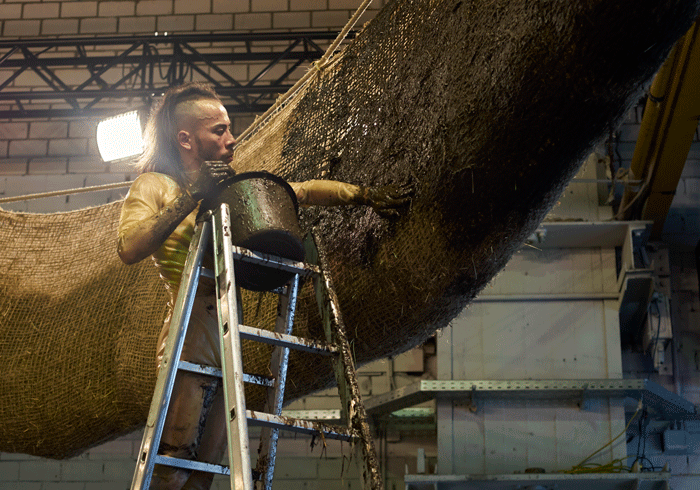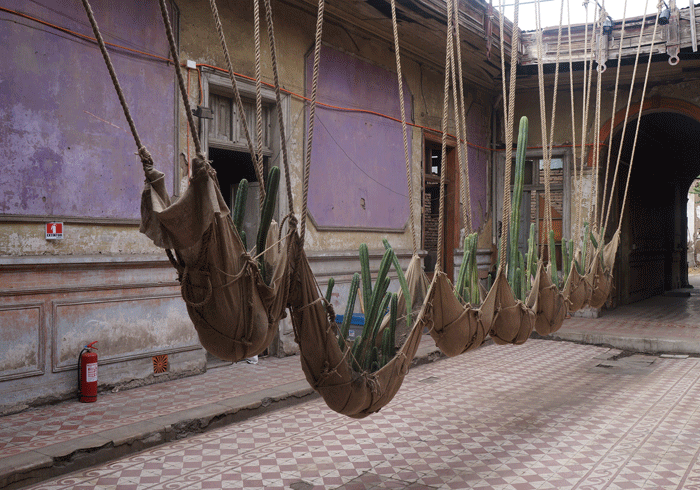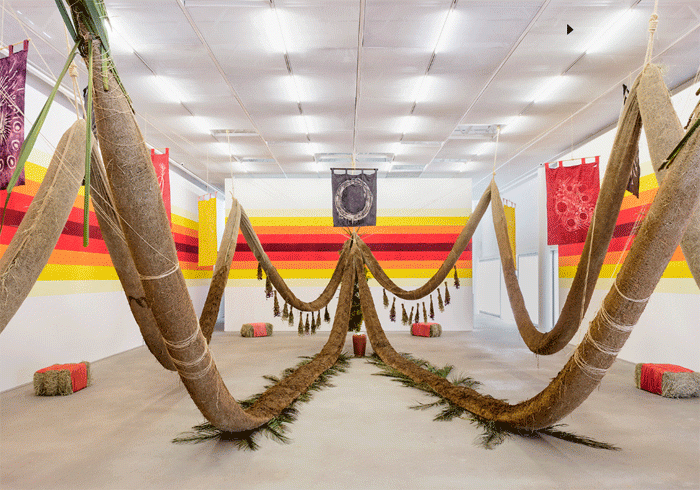Editor’s note: On the occasion of Daniel Lie’s Children of the End exhibition on through 24 March at Casa Triangulo, São Paulo, ArtReview republishes this interview from the September 2017 issue
For the most part, visual art stands before you – on the wall – or it rises up to meet you from the floor. Daniel Lie’s work arrives, most often from above. It drapes and sways and drips from the rafters. The relationship it describes is between the heavens and the dirt: looking skyward, falling earthward. Rocks cradled with rope, fruit sagging in mesh sacks, crystals the size of bowling balls suspended by a complex network of fibres.
In the twenty-nine-year-old Brazilian artist’s recent installation Death Centre for the Living (2017) at the Wiener Festwochen, viewers reclined on straw mats and gazed up into a hanging garden. Overhead, linseeds sprouted and died in a canopy of fresh soil, rotting fruit, cannabis plants, drying flowers and fermenting rice. In accord with Lie’s ‘conditions’, anyone who entered the space was to remain silent and leave ‘belongings’ outside the installation – wallet, watch, mobile phone, camera, shoes.
Throughout all of this, Lie sat inside the environment and meditated. He is often directly present in his art, and performs rituals throughout the entire process, from conception to exhibition. In interviews and at openings, he paints his face and body in bright blues and sunset reds, and dyes his eyebrows canary yellow. He costumes regularly, particularly in workmen’s uniforms, and sees dressing up as a part of the art process. He wears a single thick tail of hair down his back and shaves the rest.
For Lie, dress and body colours change frequently, and serve as an extension to his art. This kind of self-transformation began when he was working with Voodoohop, an art collective in his hometown of São Paulo, which inhabited local ‘natural hideaways and held dance parties influenced by indigenous Brazilian traditions’. Likewise, Lie’s implementation of materials is learned from traditional farming methods. Recently he’s been learning directly from the source, spending periods of his time with the Tupinambá people in the rainforests of Brazil.
On Instagram, Lie gives an intimate chronicle of his peripatetic life, floating through a series of installations and residences, both official and self-imposed. This autumn, he travels to Indonesia to make a season-long new work for the Biennale Jogja, where in preparation for the show, he will study with shamans and introduce himself to the home country of his father.

Ross Simonini: Is your art born from mysticism?
Daniel Lie: I think my work starts in thinking about death. Maybe the first mystical experience I had was the first time I saw a corpse. A relative of mine passed away, my Indonesian grandfather, and I saw the body lying on a metal table before getting his clothes changed to the funeral. I think this situation can be a democratic, open experience. A very basic question opened: where did my grandfather go? Then came another question: if we die, what’s the purpose of living? After that, when I was getting deeper in art, I tried to reach back into this experience. The way that I understood this was to reach beyond this constructed reality. So, I’ve been practising meditation. I’ve been practising Tai Chi Chuan, Vipassana meditation, Daimoku [nam-myoho-renge-kyo]. I’ve been going to a Candomblé [Afro-Brazilian cult] here in Brazil. I’ve been going deeper into the understanding of female strengths in me. Also, I’ve been experiencing different types of psychoactive elements, and I think all of this gave me, and can give, a wider understanding of life and death.
RS: Is making the work a mystical experience for you?
DL: In my work, I think the first thing is the relationship I develop with it. In one part, I try not to look for complete control of the work. I put in elements that can change throughout time. Nowadays I develop my work for a specific space and I only do it once. And I try to find different layers to connect it to this space, by personal rituals or by meeting with people who had or have a personal connection with the place. Sometimes I sleep at the venue and through my dreams I access an image, a symbology. We’re using the word ‘mystical’ and I like to use the word ‘energy’ too, but we’re talking about a certain kind of energy. Science has many words for energy: gravity, heat, electricity, magnetic fields, etc. And all of them are energy. But maybe we can call this kind of energy a field of emotion. But these words are not enough. The experience, though – it can be beyond enough.
RS: Do you channel this energy with your work?
DL: I don’t think I am channelling. I think this energy can be accessible for everyone, the thing is I feel like it’s a language and it requires dedication to be able to communicate with it. But this vision of artistic channelling can be tricky. I don’t like to place myself, as an artist, as different from everybody else. I think our society is very romantic. Here in Brazil at least, when you are an artist you are either a semigod or nearly a vagabond. So where is the middle? Where is the human, the someone normal, just like you or I? In this field of art, it’s not something understood only by your brain, but with your emotions, your body. To understand can require a deeper, wider sense of time. Maybe you don’t understand the artwork now, but in ten years it will come back to you, and that’s the period of time this artwork needed to make sense to you.
RS: Do you find that there’s resistance to this kind of thinking in the artworld?
DL: Yeah, there’s tons of taboo, and one of the easiest ways to talk about it is through scientific language. Our society believes in science, we take it as truth, as reality. Lots of things from science are only theories, but science needs to be believed. When we talk about something that is not from this field, we’re going against what society believes, so it gets diminished. When we’re talking about this holistic side, we only have a few words to describe so many different energetic processes, and that’s very frustrating.
These mystical experiences are all over art, but people don’t talk about them. Look at the construction of a museum. It’s built like a ‘sacred’ place – the way the objects are untouchable, the way these places can be very socially intimidating for some, the way the space and lighting are designed around pieces of art to enhance them, the amount of security, and even if we look at how people behave inside a museum – walking slowly, paying attention and being quiet.
Or if we look at Joseph Beuys, his whole work’s about energy and material and shamanism and rituals, but texts written about him want to talk more about his political side, involvement with the university and so on. This whole other side is not taken seriously, and I think that’s a big mistake. At the same time, as I start to connect with other fields of art, like performance, dance and theatre, there this whole subject is not as taboo as in the visual arts. Even in the academic world they talk about energy, about the unified field and how to connect and work it or be involved with it. I think the United States and countries in Europe can be even more sceptical about the subject than South American countries. In the visual arts we are especially ignorant of this, and I personally think it’s a very irresponsible attitude.
RS: Your use of organic materials seems connected to this idea of energy – soil, live plants, rotten fruit.
DL: The material is the most important part of the work. I try to bring the material as it is – meaning it can change throughout time due to living-dying processes. I am not interested in the representation of something. I’m interested in the experience directly. I used to work with synthetics, like plastic, but in 2015 I stopped. I did three solo exhibitions at the same time in São Paulo, in venues that I dreamed my whole life to work in. But I got completely tired, physically and on a spiritual level. At first I couldn’t understand why. Then I realised I was making some type of mistake because if I was doing what I believed in, why was I so drained? So after, I thought about the cycle of organic materials, how life and death are not separated, how the fungi that rot also feed the plants. I realise the synthetics did not do that, so I stopped working with plastics. Then I felt like I was able to generate energy again. This was a breaking point in my work.

RS: When did this break happen?
DL: In 2016, in Chile, in this hundred-year-old house in this central neighbourhood in Santiago called Yungay. I made a work called Asumimos de Ahora en Adelante [We Take On, From Now On]. I used hemp fabric, hemp ropes and dirt. The majority of houses in Chile are made with adobe, so I studied bioconstruction techniques and worked with these techniques for the first time. It was all handmade. I developed this adobe that was a mix of the dirt I gathered with horse manure and linseeds, and mixed everything with my hands. It was a very deep connection with the material. I spent a month doing this work. It was a very remarkable old house, almost a ruin, made of adobe. There were also a lot of dead pigeons in the place and I made some altars for them. I used the sacred cacti from Chile, Bolivia and Peru, which is called San Pedro. I worked with 55 cacti and, at the end of the installation, the people in the area could go there and collect one cactus to take home. So it spread throughout the neighbourhood. After the work was finished, all the biodegradable components went back into the earth. This was the first show I did addressing the question: how do the sacred plants influence an environment while they are alive? And this is especially towards sacred plants usually used in rituals or consumed to achieve other mind-states and living states. I also brought this question to my most recent work, Death Centre for the Living, with the two cannabis indica trees.
RS: Do you see the artist’s role as a social one?
DL: I think the artist is very important for society because we can make other people more sensitive. That’s how art has impacted me. I think nowadays the artist is very much needed for our society. To be an artist can be a calling, just like to be a shaman, a priest, a doctor – this occupation that is towards the other. I think it is a big responsibility. In Brazil a very, very important artist named Tunga recently died [in 2016], and he is a reference for me. He helped me to see art as shamanism. I felt energy from his objects and installations. I could feel it just like we can feel a living being.
RS: Does treating art as ‘work’ conflict with the artist’s spiritual role?
DL: In Brazilian Portuguese, work is trabalho. When you go to make some spiritual act, you need to bring an offering of organic materials or perform a specific ritual that we call trabalho. We call it work. The word is very open. It is a bridge between the spiritual and the labour we do every day. I want to purge myself of work, but I was born in São Paulo, which is a city completely made for work.
Three years ago, Pedro França, a Brazilian artist, gave a talk at the event Longitudes, at the institution Casa do Povo, about the artist as the producer of herself or himself. For us artists, we have to do everything. We have to be our administrator. We have to do the accounting. We have to clean up. We have to have all the skills that would make one company. We do it all by ourselves. I thought he was going to say how difficult it is and share the pain, but actually he started to say that this is the future of capitalism, the self-made person, the person that does everything, the company person. And that shocked me, to understand that I’m already creating the model of the future capitalism. I’ve been very privileged to be able to do what I do, with the historical, political and social conditions of Brazil – I would not be able to deal with all this professional side of the artworld if I hadn’t worked as an artist assistant for Leda Catunda for four years, to come to the understanding that with this type of labour we are also feeding this machine. It sometimes feels like there’s no way to completely escape, but this is the society where I was born.
From the September 2017 issue of ArtReview
